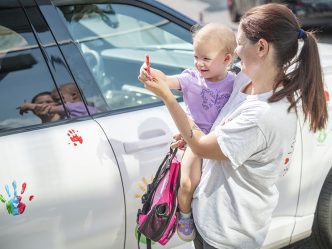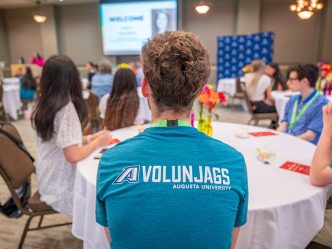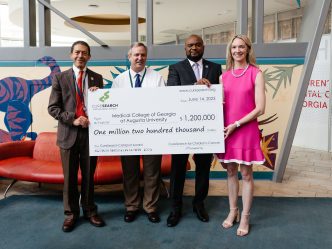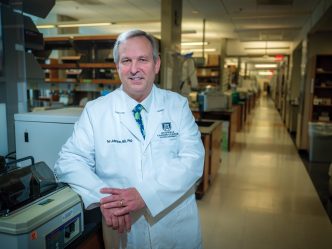Augusta University Health (formerly GRHealth) has earned a Patient-Centric Imaging Award from Health Imaging magazine for its makeover of the pediatric imaging suite at the Children’s Hospital of Georgia. The awards, developed in conjunction with the American College of Radiology, reinforce the importance of patient engagement in health care delivery and honor radiology groups for using imaging to improve quality and patient outcomes.
This is the second award for Augusta University Health – the first was earned in 2013 for patient care advances in the Breast Health Center.
“We are thrilled to be recognized again by Health Imaging for our efforts in improving the patient experience in radiology. But, by far, the most rewarding part is seeing the children smiling and laughing while they’re here. It’s like they are disappointed when they have to leave.” said Dr. James V. Rawson, chair of the Department of Radiology and Imaging at the Medical College of Georgia at Augusta University.
A pioneer in Patient- and Family-Centered Care,Augusta University Health has long recognized the importance of including patients and families in the planning process. In fact, the Children’s Hospital of Georgia, which opened in 1998, was one of the firstAugusta University Health projects designed with explicit input of patients and families, and CHOG was twice recognized with design awards from Modern Healthcare Magazine and the American Institute of Architects Academy.
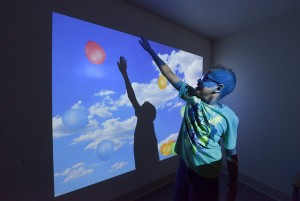
“So it was only natural to ask the experts – our young patients and their parents – when we embarked on the pediatric radiology redesign,” Rawson said. “When the first step is talking to the patient and the family, great things happen.”
The improvements included converting the traditional waiting rooms into patient lounges, the first of which is the main waiting area, which was transformed with soft lighting, comfortable chairs and the installation of an interactive video wall. As patients and siblings reach for the objects on a giant wall screen, corn kernels “pop” into popcorn, waves ripple across a puddle, bubbles float through the air, or any of about 80 other scenarios are set in motion. Families who prefer a more private waiting space may use the patient lounges inside the suite, where a series of cozy nooks are flanked with intimate seating and illuminated in varying colors of light.
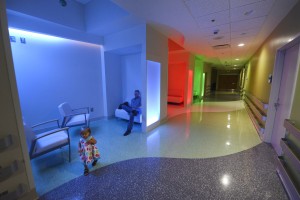
“Lighting has been an integral part of improving the patient experience in all our radiology areas at the hospital,” said Rawson. “When children enter a pediatric procedure room, they get to choose the color of lighting to help them feel more comfortable during their study.”
For fluoroscopy, the child gets to choose sound, too, such as waves crashing on the beach.
“By giving the child the opportunity to choose color, lighting and sound themes, we put them in control of their experience. On top of that, all our imaging studies are performed using low-dose techniques, because it’s vital that we limit every child’s potential for radiation exposure. It’s great to have fun, but patient safety must come first,” Rawson said.
Because the large machines used in radiology can be intimidating for a child, Augusta University Health worked with its alliance partner Philips Healthcare to install a Philips Kitten Scanner, a miniature simulated CT scanner, just outside the room that houses the actual CT scanner.
Children choose a character – a robot, elephant or alligator – to be a test patient. Then the child places the test patient on the table and slides the table through the Kitten Scanner. Since each character has a special chip inside, the scanner comes to life when the character slides through, and a voice from the machine explains what is happening during the mock exam.
“Children get to learn about their test by scanning toys in a scanner, and it helps alleviate their fears of the larger machine once they see what’s going to happen when they are on the table,” said Rawson.
And not only is the Philips Kitten Scanner an intriguing educational tool for children, but it can also help mom and dad feel more comfortable about their child’s procedure. Patients and families have reported that the new imaging suite hardly even feels like a hospital.
“No matter how many projects I work on, I am always amazed at the impact of the patient and family advisors,” said Rawson. “When you want to improve the patient experience, you start by asking the patient, and the outcome always exceeds expectations.
The renovated pediatric imaging suite opened in stages over the summer, and there will be an official ribbon-cutting event with patients, families, and staff on Oct. 20.
The 154-bed not-for-profit CHOG is the second-largest children’s hospital in the state, providing the highest level of pediatric critical care and neonatal intensive care, as well as a wide range of general and complex health care for children.
CHOG was recently ranked as the nation’s best children’s hospital in quality and safety.
Health Imaging magazine and HealthImaging.com provide business and technology news in medical imaging and healthcare information technology, radiology, cardiology, oncology, radiation oncology, nuclear medicine and molecular imaging. The magazine and website focus on economics, practice and informatics in imaging and are published by TriMed Media Group, Inc.
 Augusta University
Augusta University

